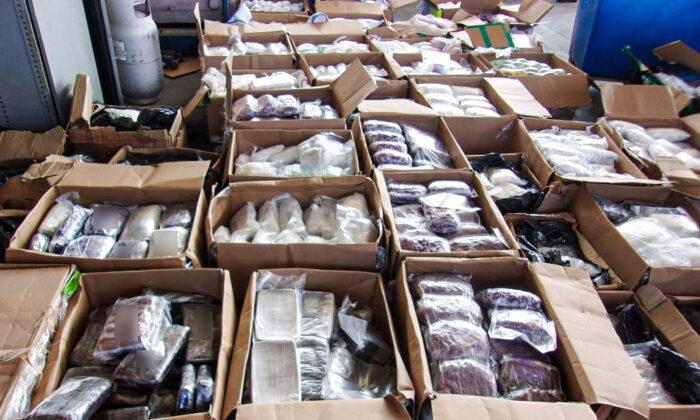The number of Americans fatally overdosing from illegally manufactured fentanyl laced with the animal tranquilizer xylazine soared between 2019 and 2022, according to data published by the Centers for Disease Control and Prevention (CDC) on June 30.
Specifically, the total monthly number of illicitly manufactured fentanyl (IMF) deaths with xylazine increased from 12 in January 2019 to 188 in June 2022.
Between January 2021 through June 2022, xylazine was detected in 4,859 IMF-involved deaths, amounting to 9 percent of the 53,969 IMF-involved deaths among 32 jurisdictions, the CDC said.
The substance was also co-involved—meaning it was listed as a cause of death on the death certificate or medical examiner’s or coroner’s report—in 6.9 percent, or 3,735, of those deaths between 2021 and 2022.
According to the CDC, the states with the highest number of IMF-involved deaths with xylazine detected were Maryland (27.7 percent or 923 deaths), Connecticut (26.4 percent or 507 deaths), and Pennsylvania (23.3 percent or 1,285 deaths).
The CDC noted that the “timing and magnitude of increase” in the detection of xylazine among IMF-involved deaths may be in part due to the increased frequency of testing as well as a “true increased presence in the drug supply” in recent years.
What Is Xylazine?
Dr. Rahul Gupta, director of the White House Office of National Drug Control Policy, said the data show that fentanyl combined with xylazine is increasingly dangerous and deadly.“This is why the Biden-Harris Administration recently designated it as an emerging threat,” Gupta said in a statement. “The Administration is working tirelessly to launch a whole-of-government approach to tackle this emerging threat head-on, protect public health and public safety, and save lives.”
The tranquilizer is primarily used for sedation, anesthesia, muscle relaxation, and analgesia in animals such as horses, cows, cats, and other non-human mammals.
Xylazine has never been approved for human use but has, over the years, found its way into America’s illicit drug supply, with drug dealers—predominantly the Sinaloa and Jalisco cartels in Mexico—mixing it with other narcotics like cocaine, heroin, and fentanyl to enhance their effects or increase their weight and thus their street value.
Xylazine Designated ‘An Emerging Threat’
According to the National Institute on Drug Abuse (NIDA), xylazine causes drowsiness and amnesia and can slow down breathing, heart rate, and blood pressure to dangerously low levels.Repeated use of xylazine can cause severe wounds or skin ulcers, abscesses, and a string of other health complications. People who inject drug mixtures containing xylazine can also develop necrosis—the death of skin and organ tissue—which may lead to amputation, according to the U.S. Drug Enforcement Administration (DEA).
Taking opioids in combination with xylazine and other central nervous system depressants such as alcohol or benzodiazepines such as Xanax increases the risk of life-threatening overdose.
Because xylazine is not an opioid, the opioid overdose reversal drug naloxone (sold under the brand name Narcan), does not help address xylazine’s effects on breathing.
In April 2023, the White House Office of National Drug Control Policy designated fentanyl adulterated or associated with xylazine as an emerging threat to the United States.
CDC provisional data estimates that more than two-thirds (68 percent) of the reported 107,081 drug overdose deaths in the United States in 2022 involved synthetic opioids other than methadone, principally illicitly manufactured fentanyl.
Prior to June 2021, the United States had never had more than 100,000 overdose deaths in a single year.
In an effort to address national drug control programs, the Biden administration has requested $46.1 billion from Congress, marking a $5 billion increase from the FY 2022 request, and a $2.3 billion increase over the FY 2023 enacted level.





